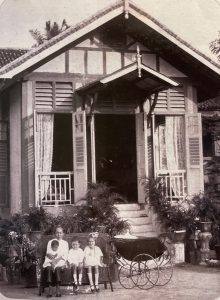History of Church of St Michael
1900s
At the turn of the century, St Michael’s estate was seen as a nice residential area with huge bungalows and big gardens – an average 20,000 sq feet each, about the size of the plot of land the church stands on-that could be bought at a reasonable price. St Michael’s Road led towards a hillock on top of which was built the Telecoms house, roughly at the place of the CTE now. Slowly, the estate became known as a Eurasian enclave, with families moving out of Queen Street and Selegie Road into St Michael’s. Compared to the bustle of town, the air here was fresh and invigorating. This was helped by the fact that a rail car running along Serangoon Road made it easy for residents to head back into town. Unlike Katong, which was seen as a holiday getaway, St Michael’s was a place to build a home.
The area of St Michael’s was all swamp and sand pits. It was part of the well-known Whampoa Gardens, belonging to Hoo Ah Kay, the wealthy English-speaking merchant who had a sawmill by the river and whose house was the place for high society parties at that time. Further up where Potong Pasir is now, were dangerous sand pits, while Toa Payoh was mere marsh land.

Photo credit: Mrs Margaret Clarke as a baby in her father’s house
1920s to 1950s
At that time, there were about 40 to 50 Eurasian families at St Michael’s estate, mostly Catholic, with a smattering of Chinese and Indian families. Everyone knew each other and a sense of closeness prevailed.
The Catholics’ spiritual needs were looked after by the priests from the Cathedral of the Good Shepherd. Many who used to live in the area still remember that from about 1944 until his death in 1957,Fr M Bonamy would cycle from the Cathedral to their homes and celebrate Mass there.
House Masses were rare in those days but as a parish priest in Kedah, Fr Bonamy used to celebrate Mass in the rubber plantations. Singapore was no exception. During the Japanese Occupation, he would also give catechism classes at the De Souza house in St Francis Road.
Says Elisabeth Eber-Chan,”St George’s Road was noted for its todi shops and on pay day Tamil labourers could be seen snoring away on the pavement. There was also a Hungarian wrestler named King Kong who used to visit friends in the estate. Small boys would stare at him in amazement and laugh at his high-pitched voice, which contrasted with his bulk. And nearer the junction of St Michael’s Road lived an Arab lady who told fortunes from the dregs in tea cups.”
There was a sauce factory in the area which was cheap and good. By the Kallang River Indian Cowherds would bathe and clean their cattle. There were no paved roads, just mud tracks.

Photo credit (top): the first church, a two- story bungalow
Photo credit (above): Priests (left to right) Fr Joachim Choy, Fr John Lei, Fr Francis Tan with Altar boys in the 1960s
It was only after World War II that religious institutions in the area began to grow – first, the Pentecostal Church where the CTE is now, then the Sri Lankaramaya Temple in 1947. In fact, in 2000, the monks celebrated the 50th anniversary of the Bodhi tree planted there in the temple’s early years.
Later, between 1956 and 1957, the Mar Thoma Church and School were built at the end of St Michael’s Road; these buildings later gave way to the CTE.
Look out for more on the rich history as we celebrate the 60th anniversary of our parish this year!
Adapted from: Church of St Michael’s 40th Anniversary yearbook
